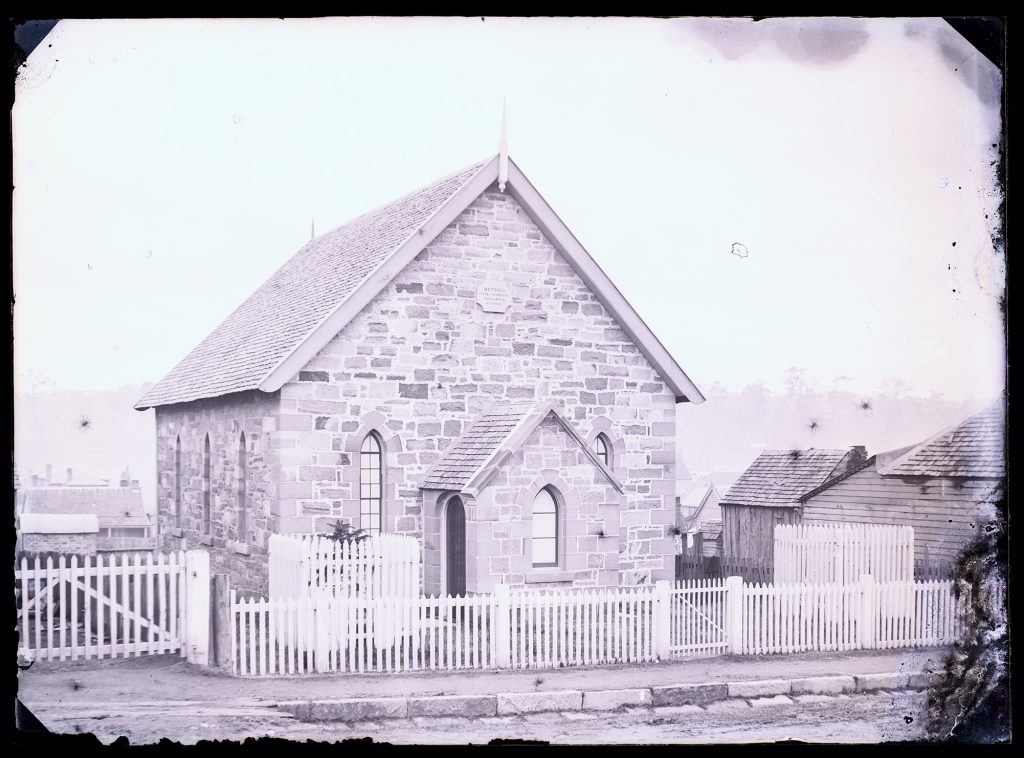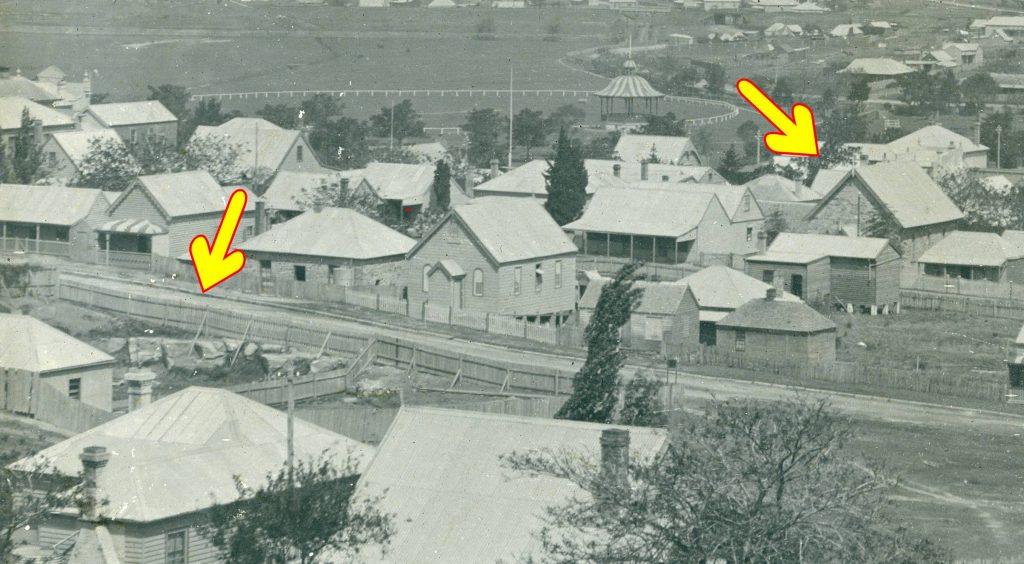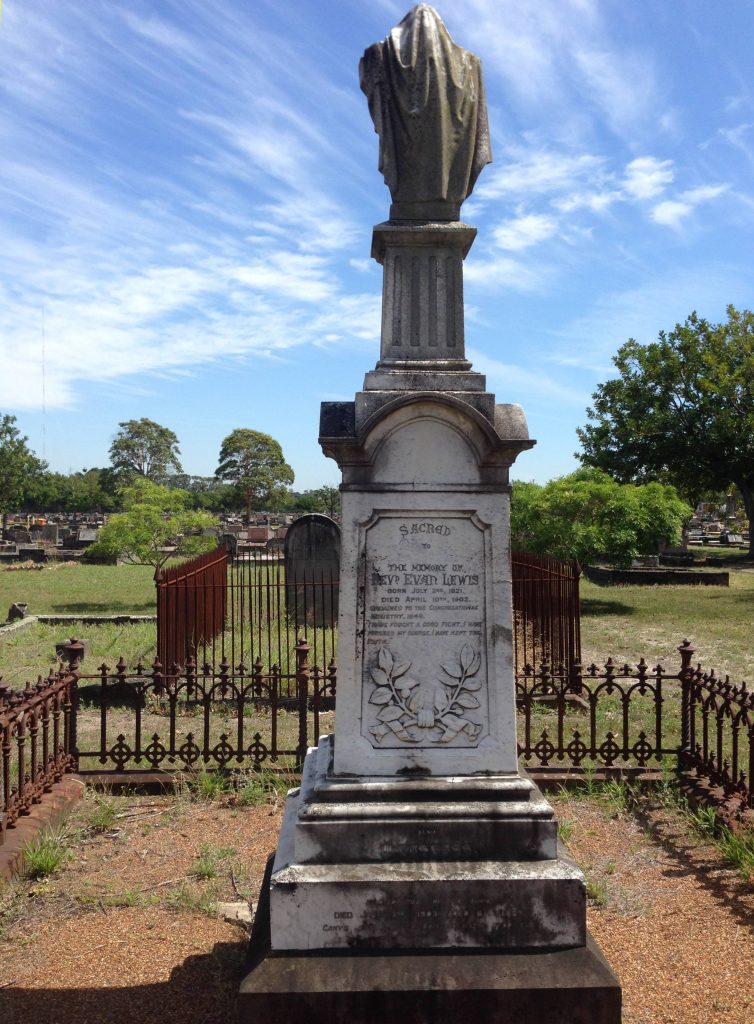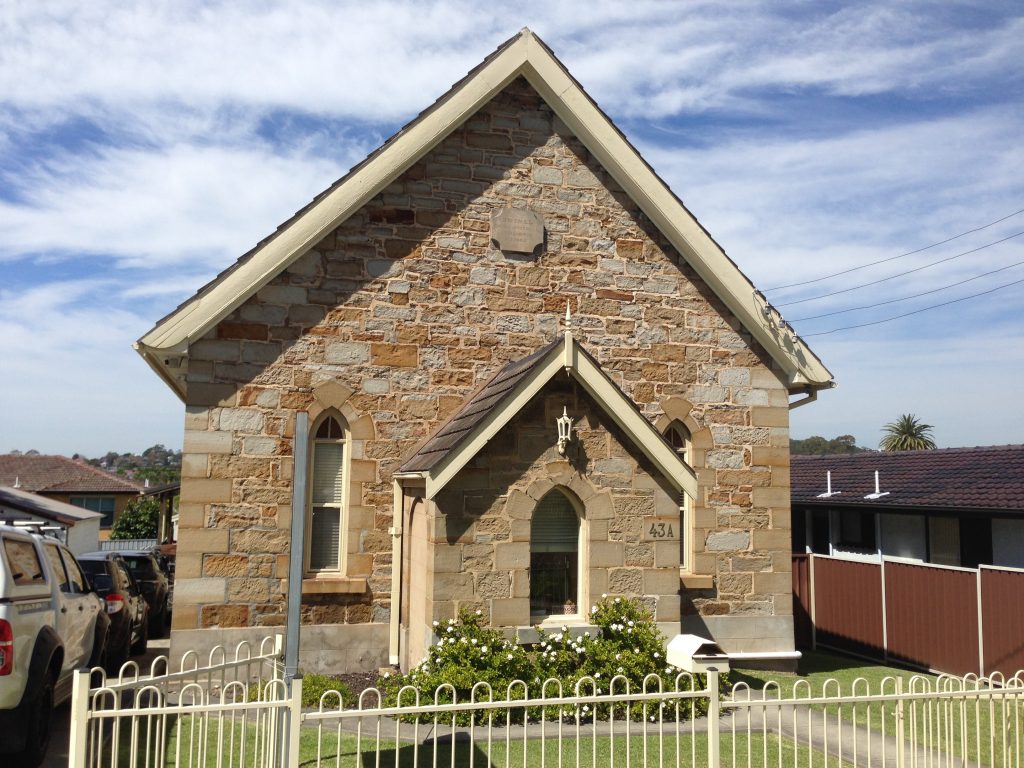In Minmi in 1864, after a period of torrential rain, a fissure opened beside Back Creek. The contents of the creek poured in, and the colliery below flooded. All the miners managed to escape, but the pit was closed for months afterwards.
Forced to look elsewhere for employment, a group of Welsh miners moved from Minmi to work the newly opened colliery in Lambton. The men belonged to the Welsh Congregational Church, under the leadership of Rev Evan Lewis. They soon erected a simple wood slab church on De Vitre St. The uncertainty of mining meant that most buildings in Lambton at that time were of a similar primitive and temporary character.
In 1868 however, the Welsh miners expressed a confidence in Lambton below, to match their assurance in God above. They decided that a new building, worthy of its great purpose, should be built of stone. They were granted permission to use a quarry on Newcastle Rd nearby, and the men bound themselves “one to another” in an oath, that they would erect a new building in Dickson St, by their own hands, free of charge.
At the 50th anniversary celebrations in 1918 it was remembered that “Some of the men quarried the stone, others wheeled it to the site, and many, after their shift ended at the pit for the day, put in several hours in building the edifice. One of the workers was Mr. J. Parry, who, though then a coalminer, had originally been a stonemason.”
Above the front porch, an engraving in Welsh reads “Bethel capel annibynol adeiladwyd, A.D. 1868” which translates to “Bethel Independent Chapel, built A.D. 1868” The building ceased to be used as a place of worship in 1977, when the Congregationalists merged with the Uniting Church.
Next year will be the 150th anniversary of the stone building, which stands today as an enduring legacy of the faith of those Welsh miners, even in troubled times past.

The article above was first published in the December 2017 edition of the Lambton & New Lambton Local.
Additional information
Acknowledgements
An important source of information for this article was pages 84-85 of “The Story of Lambton”, published by the Newcastle Family Historical Society. In particular, it has details of the binding oath that the men of the church made regarding the construction of the stone church. A handwritten account by Deacon Richard Thomas details the genesis of the oath, as the men considered the future while maintaining the property of the earlier wooden building.
“One day about seven of us were fencing this ground, it was a warm day and we were taking a spell in the shade of the building. One of the party said ‘to see whether we are in earnest or not let us prove it. I am prepared to give five pounds towards it and one pound each for my three sons.’ At once each of the party promised five pounds. That same day Mr David Williams said he knew of a quarry, not more than a hundred yards away, where there were plenty of stones, if we could get permission to open it. That was in Young Road (now a section of Newcastle Road) between Grainger and Hill Streets on the Waratah Coal Company’s ground. A deputation interviewed the Manager, asking permission to open the quarry. Permission was freely granted, and it was decided to have a stone structure. We decided that in order to save expense we would bind ourselves one to another and that we would quarry the stones and bring them to the place free of charge. We worked hard and remained true to each other, without a hitch. I need not mention that it was a big contract for about seven or eight men.”
Clarifications
When dealing with the history of churches in Lambton, it is important not to confuse churches with similar names. For instance the Welsh Baptist Church was different to the Welsh Congregational Church, even though the the minister of the Welsh Congregationalist Church, the Rev Evan Lewis often also preached at the Welsh Baptist Church. Also the Welsh Congregationalists were different to the English Congregationalists, although they later merged in 1904.
Date of Opening
One aspect of the story of the stone Congregational church in Lambton that is slightly frustrating, is pinning down the date of opening. “The Story of Lambton” p. 84 states that “the chapel was completed and opened for worship in June 1868.” However I cannot find any evidence for this date. I have found three newspaper articles in Trove that give a bit of a timeline …
- 24 Jun 1868 – After noting that the Primitive Methodist are enlarging their building, the report notes that “the Congregationalists are about to make a similar movement, as their chapel is found to be not sufficiently commodious for the hearers.”
- 12 Nov 1868 – “The erection of the Primitive Methodist and Welsh Chapels are being proceeded with, and the work has already made considerable progress.”
- 25 Feb 1869 – “The new Welsh Church is on the eve of being completed, and will be opened for public worship ere long.”
Whereas most churches in that era, on the completion of their building held a formal opening service that was well reported in the newspaper, the Welsh Congregationalists don’t appear to have had a formal opening of their small but impressive stone building.
One thought I had in trying to pin down an opening date, was to look in Trove for reports of anniversary services in subsequent years. There were many such reports, but it turns out that the Welsh Congregationalists managed to hold anniversary services variously in the months of June, July, August, September, October, and November. To make matters even more confusing, an eighth anniversary was celebrated in 1877 implying an opening year of 1869, but a 76th anniversary was celebrated in 1944 implying an opening year of 1868.
The best sense I can make of all this is that the church construction took place mostly in 1868 (hence the stone inscription on the front of the church), but that it only began to be used in 1869, and that there was no formal or official opening ceremony.
The quarry
The stone for the church in Dickson St was obtained from a nearby quarry on Young St, now Newcastle Rd. We know that the power station for the electric light scheme instituted in 1890 was built in a disused quarry. There is no definite proof, but it seems highly likely that this was the quarry used for the church. A 1904 panorama of the Lambton taken from the top of Noble St shows the both the quarry and the church in close proximity.

Rev Evan Lewis

Newspaper articles
| Article Date Event Date | Notes |
|---|---|
| 8 Jun 1864 3 Jun 1864 | Inundation of the workings of the Melbourne and Newcastle Minmi Colliery Company, after a period of torrential rain.
"No cloud is, however, without a silver lining, and in this case there is a pleasing relief to the dark side of the picture, in the employment afforded by the other coal associations to the men left without work by the Minmi inundation." … "We may say that, beyond a change of residence, but little inconvenience will result to the men so suddenly deprived of their former scene of labour." |
| 11 Jun 1864 | Further details on the flooding of the Minmi colliery: "It appears that it was not the bed of the creek which yielded, but a fissure was created six yards distant from it. This gap is now being filled up, and a breastwork composed of logs and clay has been built up in front, to guard against a similar occurrence." |
| 27 Aug 1864 | “It will be twelve weeks on Friday next since the mine was filled with water by the creek breaking in during a heavy rain storm, and what was previously a flourishing busy community, has, by this long period of inactivity, been brought to a very low state in its prosperity ; for with the exception of a few men who remained to assist in clearing the water out of the pit, the great bulk of the colliers found employment at the neighbouring collieries, and in many instances removed their wives and families.” |
| 24 Jun 1868 | After noting that the Primitive Methodist are enlarging their building, the report notes that "the Congregationalists are about to make a similar movement, as their chapel is found to be not sufficiently commodious for the hearers." |
| 26 Sep 1877 23 Sep 1877 | Eighth anniversary celebrations of the Lambton Welsh Congregational Church. |
| 21 Aug 1944 17 Aug 1944 | The 76th anniversary celebrations of the Lambton Congregationalists, held in their "spacious hall, recently renovated." |


My wife and I were having a conversation as to the location of the Welsh Church in Newcastle, and I didn’t realize it was located in Dickson Street, Lambton. Though we’re not Welsh descendants we do have in our media room what we believe to be the organ from this same church. It’s a “FARFISA” organ which would have been purchase either in the 1950’s or 1960’s to replace the original pump organ. My mother claims it was gifted to her from the congregation upon the church’s closure.
Be careful with saying “the Welsh Church in Newcastle” – there were lots of Welsh churches in Newcastle. In fact there were three different Welsh churches just in Lambton! The Welsh Congregational church in Dickson St, the Welsh Calvinistic Methodists in Young St, and the Welsh Baptists in Elder St.
Good morning The Rev Evan Lewis was my Great great grandfather. I would love to hear from anyone else related. Suzanne Garrett grandaughter of Mary Eva Jones/Thomas. She was the daughter of lucretia Lewis. Thank you. suzanneblodwen@gmail.com
Great to read of such dedication to the building of this church.
Thank you for the effort in putting it together.
I have referred to your blog on my website. http://www.churchesaustralia.org
Regards
John Conn
Wow! How interesting to read of this beautiful old Church. Being of Welsh descent, my Grandmother , Mary Elizabeth Lewis was born in Cardiff, Wales, I am intrigued with whatever History abounds in the Hunter area, especially with the many mines and disasters,the Welsh Hymn Singing Festivals, Welsh Choirs now defunct, what a shame the Congregationalists merged with the Uniting Church, as that merger has led to so many Churches being closed .At least Kurri Kurri “Cons” and West Cessnock are still functioning. Must take a look at this beautiful old building. If walls could only speak!!!! The Hymn singing must have been spectacular, brings tears to my eyes thinking about it! Thank you so much for this site, Regards, Marelle P.
A very interesting piece of local history. As a Congregationalist myself, I could not help a wry smile at the mention of the “Primitive Methodists”. I would love a look inside as it is these days. Pehaps I could try and get a haircut there!
My father Lyn Emlyn Jones a proud Welsh speaking Welshman was minister here in the early 1970s